Operations Management: Frameworks, Historical Context, and Processes
VerifiedAdded on 2023/06/10
|13
|3754
|378
Report
AI Summary
This report provides a comprehensive overview of operations management principles, starting with an analysis of Porter's Five Forces framework and its application to operations strategy. It delves into the historical development of operations management, highlighting the impact of key advancements such as just-in-time systems, supply chain management, and e-commerce. The report also details the product design process, including idea generation, concept development, testing, and specification development, and provides a break-even analysis for Maverick Backpacks at various production levels. Furthermore, it discusses process performance metrics like organizational growth, quality, and value, compares different supply chain designs, and examines the merits of outsourcing. The report concludes with a section referencing the Federal Trade Commission (FTC).

RUNNING HEAD: Operations Management
Operations Management
Operations Management
Paraphrase This Document
Need a fresh take? Get an instant paraphrase of this document with our AI Paraphraser
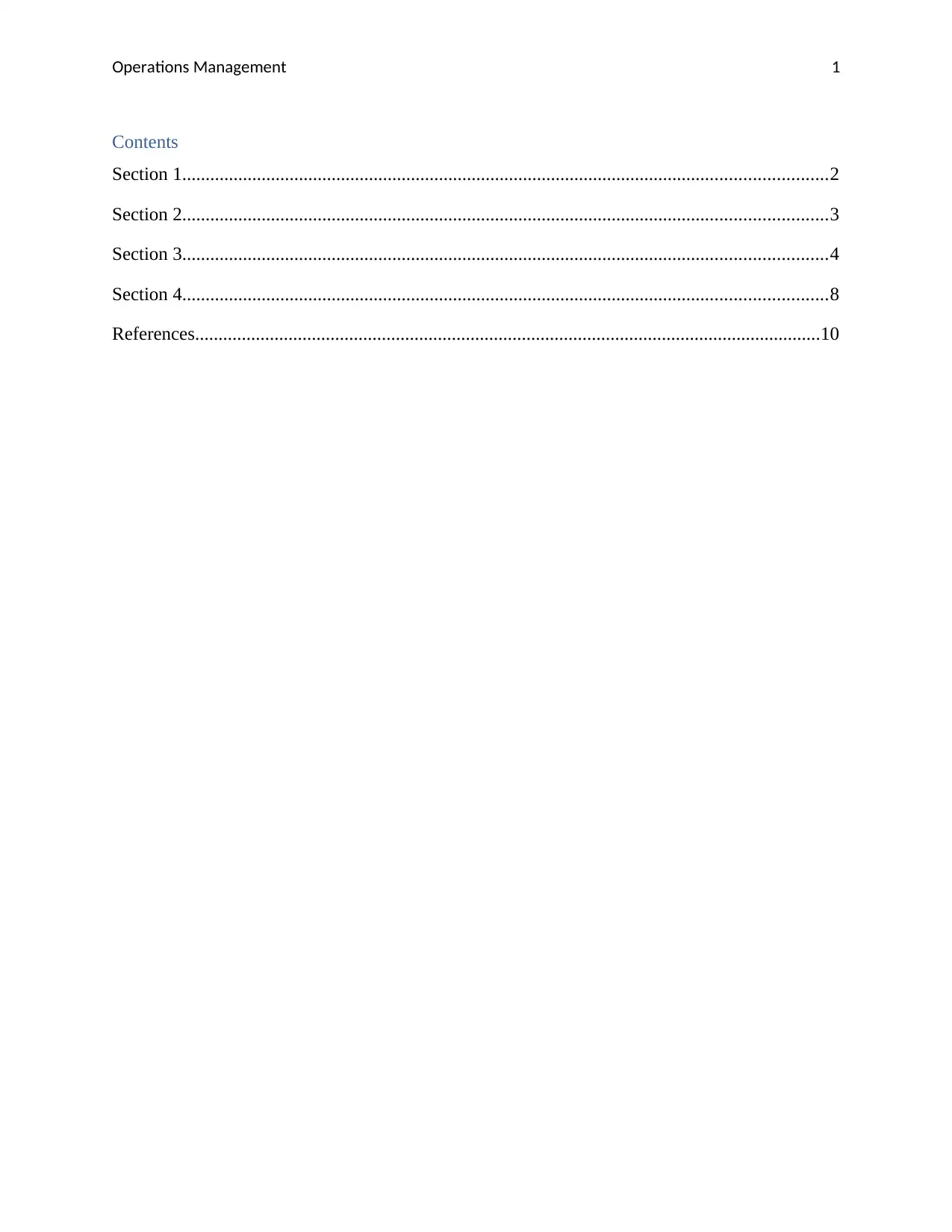
Operations Management 1
Contents
Section 1..........................................................................................................................................2
Section 2..........................................................................................................................................3
Section 3..........................................................................................................................................4
Section 4..........................................................................................................................................8
References......................................................................................................................................10
Contents
Section 1..........................................................................................................................................2
Section 2..........................................................................................................................................3
Section 3..........................................................................................................................................4
Section 4..........................................................................................................................................8
References......................................................................................................................................10
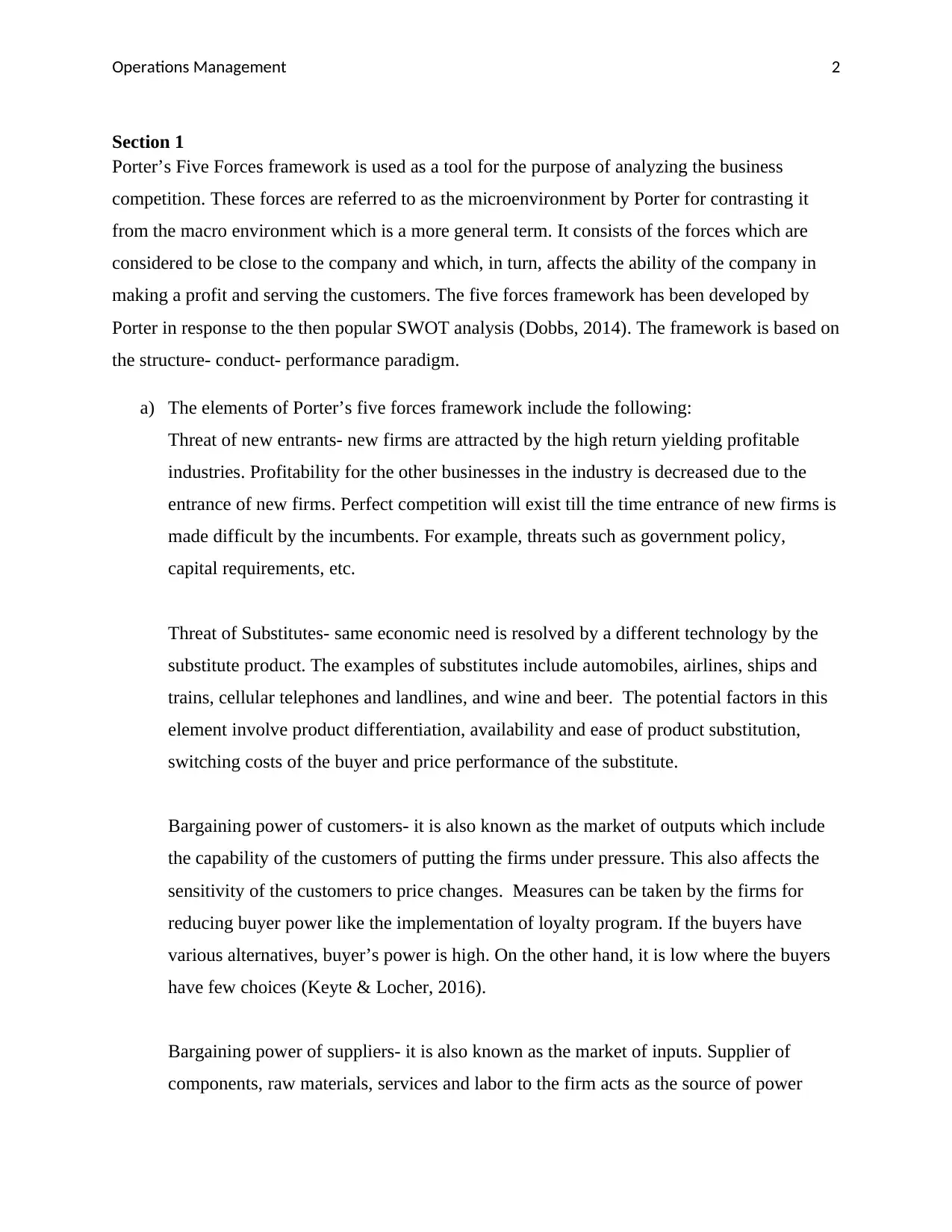
Operations Management 2
Section 1
Porter’s Five Forces framework is used as a tool for the purpose of analyzing the business
competition. These forces are referred to as the microenvironment by Porter for contrasting it
from the macro environment which is a more general term. It consists of the forces which are
considered to be close to the company and which, in turn, affects the ability of the company in
making a profit and serving the customers. The five forces framework has been developed by
Porter in response to the then popular SWOT analysis (Dobbs, 2014). The framework is based on
the structure- conduct- performance paradigm.
a) The elements of Porter’s five forces framework include the following:
Threat of new entrants- new firms are attracted by the high return yielding profitable
industries. Profitability for the other businesses in the industry is decreased due to the
entrance of new firms. Perfect competition will exist till the time entrance of new firms is
made difficult by the incumbents. For example, threats such as government policy,
capital requirements, etc.
Threat of Substitutes- same economic need is resolved by a different technology by the
substitute product. The examples of substitutes include automobiles, airlines, ships and
trains, cellular telephones and landlines, and wine and beer. The potential factors in this
element involve product differentiation, availability and ease of product substitution,
switching costs of the buyer and price performance of the substitute.
Bargaining power of customers- it is also known as the market of outputs which include
the capability of the customers of putting the firms under pressure. This also affects the
sensitivity of the customers to price changes. Measures can be taken by the firms for
reducing buyer power like the implementation of loyalty program. If the buyers have
various alternatives, buyer’s power is high. On the other hand, it is low where the buyers
have few choices (Keyte & Locher, 2016).
Bargaining power of suppliers- it is also known as the market of inputs. Supplier of
components, raw materials, services and labor to the firm acts as the source of power
Section 1
Porter’s Five Forces framework is used as a tool for the purpose of analyzing the business
competition. These forces are referred to as the microenvironment by Porter for contrasting it
from the macro environment which is a more general term. It consists of the forces which are
considered to be close to the company and which, in turn, affects the ability of the company in
making a profit and serving the customers. The five forces framework has been developed by
Porter in response to the then popular SWOT analysis (Dobbs, 2014). The framework is based on
the structure- conduct- performance paradigm.
a) The elements of Porter’s five forces framework include the following:
Threat of new entrants- new firms are attracted by the high return yielding profitable
industries. Profitability for the other businesses in the industry is decreased due to the
entrance of new firms. Perfect competition will exist till the time entrance of new firms is
made difficult by the incumbents. For example, threats such as government policy,
capital requirements, etc.
Threat of Substitutes- same economic need is resolved by a different technology by the
substitute product. The examples of substitutes include automobiles, airlines, ships and
trains, cellular telephones and landlines, and wine and beer. The potential factors in this
element involve product differentiation, availability and ease of product substitution,
switching costs of the buyer and price performance of the substitute.
Bargaining power of customers- it is also known as the market of outputs which include
the capability of the customers of putting the firms under pressure. This also affects the
sensitivity of the customers to price changes. Measures can be taken by the firms for
reducing buyer power like the implementation of loyalty program. If the buyers have
various alternatives, buyer’s power is high. On the other hand, it is low where the buyers
have few choices (Keyte & Locher, 2016).
Bargaining power of suppliers- it is also known as the market of inputs. Supplier of
components, raw materials, services and labor to the firm acts as the source of power
⊘ This is a preview!⊘
Do you want full access?
Subscribe today to unlock all pages.

Trusted by 1+ million students worldwide
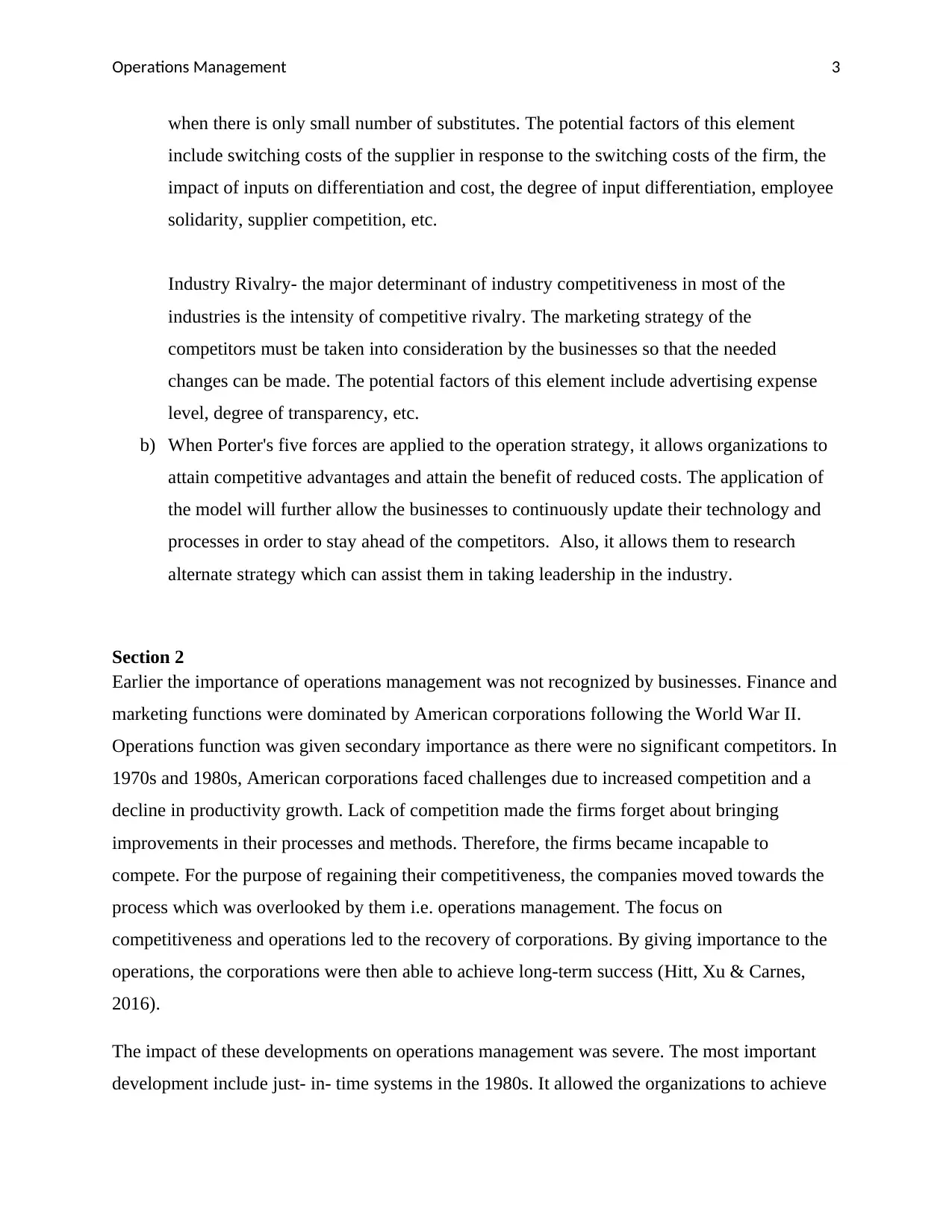
Operations Management 3
when there is only small number of substitutes. The potential factors of this element
include switching costs of the supplier in response to the switching costs of the firm, the
impact of inputs on differentiation and cost, the degree of input differentiation, employee
solidarity, supplier competition, etc.
Industry Rivalry- the major determinant of industry competitiveness in most of the
industries is the intensity of competitive rivalry. The marketing strategy of the
competitors must be taken into consideration by the businesses so that the needed
changes can be made. The potential factors of this element include advertising expense
level, degree of transparency, etc.
b) When Porter's five forces are applied to the operation strategy, it allows organizations to
attain competitive advantages and attain the benefit of reduced costs. The application of
the model will further allow the businesses to continuously update their technology and
processes in order to stay ahead of the competitors. Also, it allows them to research
alternate strategy which can assist them in taking leadership in the industry.
Section 2
Earlier the importance of operations management was not recognized by businesses. Finance and
marketing functions were dominated by American corporations following the World War II.
Operations function was given secondary importance as there were no significant competitors. In
1970s and 1980s, American corporations faced challenges due to increased competition and a
decline in productivity growth. Lack of competition made the firms forget about bringing
improvements in their processes and methods. Therefore, the firms became incapable to
compete. For the purpose of regaining their competitiveness, the companies moved towards the
process which was overlooked by them i.e. operations management. The focus on
competitiveness and operations led to the recovery of corporations. By giving importance to the
operations, the corporations were then able to achieve long-term success (Hitt, Xu & Carnes,
2016).
The impact of these developments on operations management was severe. The most important
development include just- in- time systems in the 1980s. It allowed the organizations to achieve
when there is only small number of substitutes. The potential factors of this element
include switching costs of the supplier in response to the switching costs of the firm, the
impact of inputs on differentiation and cost, the degree of input differentiation, employee
solidarity, supplier competition, etc.
Industry Rivalry- the major determinant of industry competitiveness in most of the
industries is the intensity of competitive rivalry. The marketing strategy of the
competitors must be taken into consideration by the businesses so that the needed
changes can be made. The potential factors of this element include advertising expense
level, degree of transparency, etc.
b) When Porter's five forces are applied to the operation strategy, it allows organizations to
attain competitive advantages and attain the benefit of reduced costs. The application of
the model will further allow the businesses to continuously update their technology and
processes in order to stay ahead of the competitors. Also, it allows them to research
alternate strategy which can assist them in taking leadership in the industry.
Section 2
Earlier the importance of operations management was not recognized by businesses. Finance and
marketing functions were dominated by American corporations following the World War II.
Operations function was given secondary importance as there were no significant competitors. In
1970s and 1980s, American corporations faced challenges due to increased competition and a
decline in productivity growth. Lack of competition made the firms forget about bringing
improvements in their processes and methods. Therefore, the firms became incapable to
compete. For the purpose of regaining their competitiveness, the companies moved towards the
process which was overlooked by them i.e. operations management. The focus on
competitiveness and operations led to the recovery of corporations. By giving importance to the
operations, the corporations were then able to achieve long-term success (Hitt, Xu & Carnes,
2016).
The impact of these developments on operations management was severe. The most important
development include just- in- time systems in the 1980s. It allowed the organizations to achieve
Paraphrase This Document
Need a fresh take? Get an instant paraphrase of this document with our AI Paraphraser
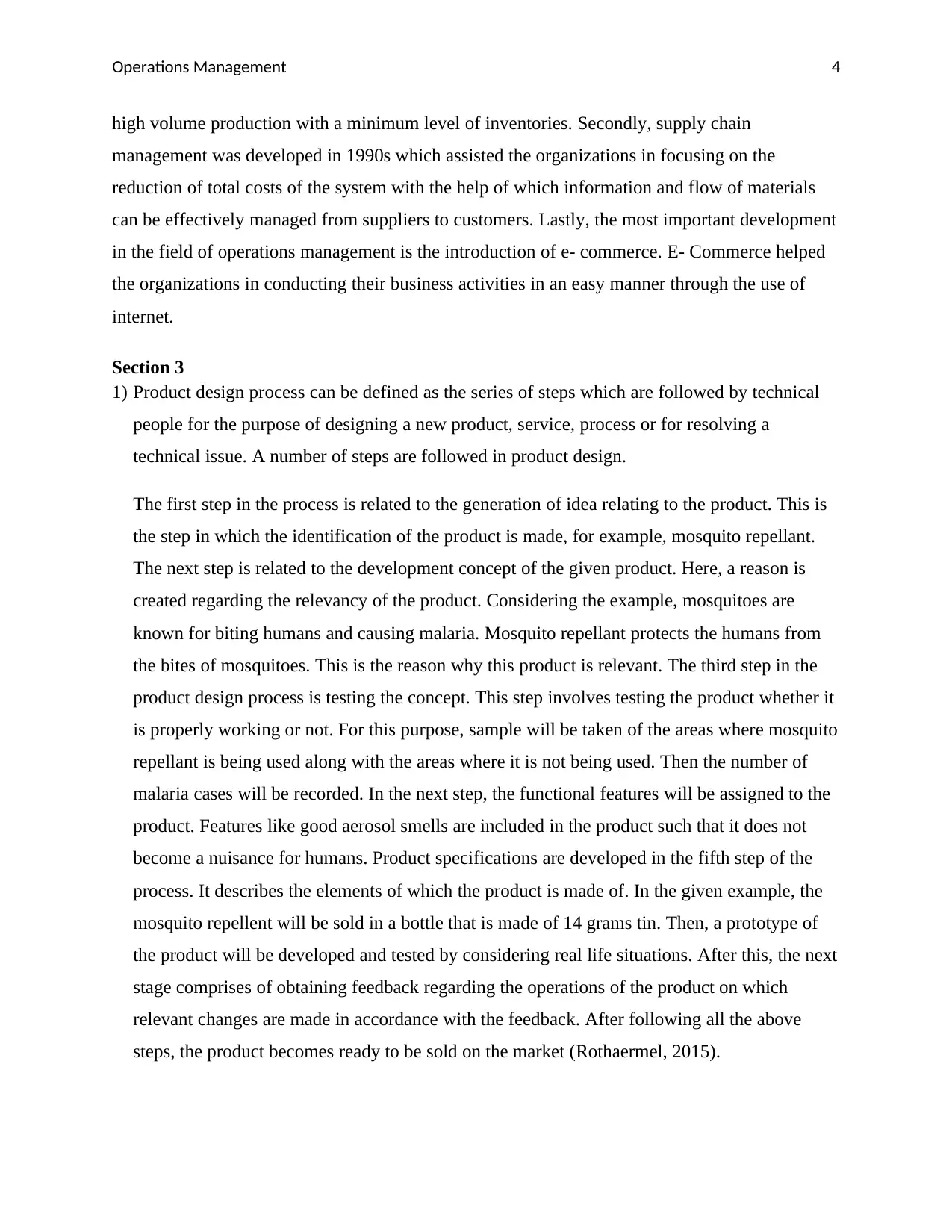
Operations Management 4
high volume production with a minimum level of inventories. Secondly, supply chain
management was developed in 1990s which assisted the organizations in focusing on the
reduction of total costs of the system with the help of which information and flow of materials
can be effectively managed from suppliers to customers. Lastly, the most important development
in the field of operations management is the introduction of e- commerce. E- Commerce helped
the organizations in conducting their business activities in an easy manner through the use of
internet.
Section 3
1) Product design process can be defined as the series of steps which are followed by technical
people for the purpose of designing a new product, service, process or for resolving a
technical issue. A number of steps are followed in product design.
The first step in the process is related to the generation of idea relating to the product. This is
the step in which the identification of the product is made, for example, mosquito repellant.
The next step is related to the development concept of the given product. Here, a reason is
created regarding the relevancy of the product. Considering the example, mosquitoes are
known for biting humans and causing malaria. Mosquito repellant protects the humans from
the bites of mosquitoes. This is the reason why this product is relevant. The third step in the
product design process is testing the concept. This step involves testing the product whether it
is properly working or not. For this purpose, sample will be taken of the areas where mosquito
repellant is being used along with the areas where it is not being used. Then the number of
malaria cases will be recorded. In the next step, the functional features will be assigned to the
product. Features like good aerosol smells are included in the product such that it does not
become a nuisance for humans. Product specifications are developed in the fifth step of the
process. It describes the elements of which the product is made of. In the given example, the
mosquito repellent will be sold in a bottle that is made of 14 grams tin. Then, a prototype of
the product will be developed and tested by considering real life situations. After this, the next
stage comprises of obtaining feedback regarding the operations of the product on which
relevant changes are made in accordance with the feedback. After following all the above
steps, the product becomes ready to be sold on the market (Rothaermel, 2015).
high volume production with a minimum level of inventories. Secondly, supply chain
management was developed in 1990s which assisted the organizations in focusing on the
reduction of total costs of the system with the help of which information and flow of materials
can be effectively managed from suppliers to customers. Lastly, the most important development
in the field of operations management is the introduction of e- commerce. E- Commerce helped
the organizations in conducting their business activities in an easy manner through the use of
internet.
Section 3
1) Product design process can be defined as the series of steps which are followed by technical
people for the purpose of designing a new product, service, process or for resolving a
technical issue. A number of steps are followed in product design.
The first step in the process is related to the generation of idea relating to the product. This is
the step in which the identification of the product is made, for example, mosquito repellant.
The next step is related to the development concept of the given product. Here, a reason is
created regarding the relevancy of the product. Considering the example, mosquitoes are
known for biting humans and causing malaria. Mosquito repellant protects the humans from
the bites of mosquitoes. This is the reason why this product is relevant. The third step in the
product design process is testing the concept. This step involves testing the product whether it
is properly working or not. For this purpose, sample will be taken of the areas where mosquito
repellant is being used along with the areas where it is not being used. Then the number of
malaria cases will be recorded. In the next step, the functional features will be assigned to the
product. Features like good aerosol smells are included in the product such that it does not
become a nuisance for humans. Product specifications are developed in the fifth step of the
process. It describes the elements of which the product is made of. In the given example, the
mosquito repellent will be sold in a bottle that is made of 14 grams tin. Then, a prototype of
the product will be developed and tested by considering real life situations. After this, the next
stage comprises of obtaining feedback regarding the operations of the product on which
relevant changes are made in accordance with the feedback. After following all the above
steps, the product becomes ready to be sold on the market (Rothaermel, 2015).
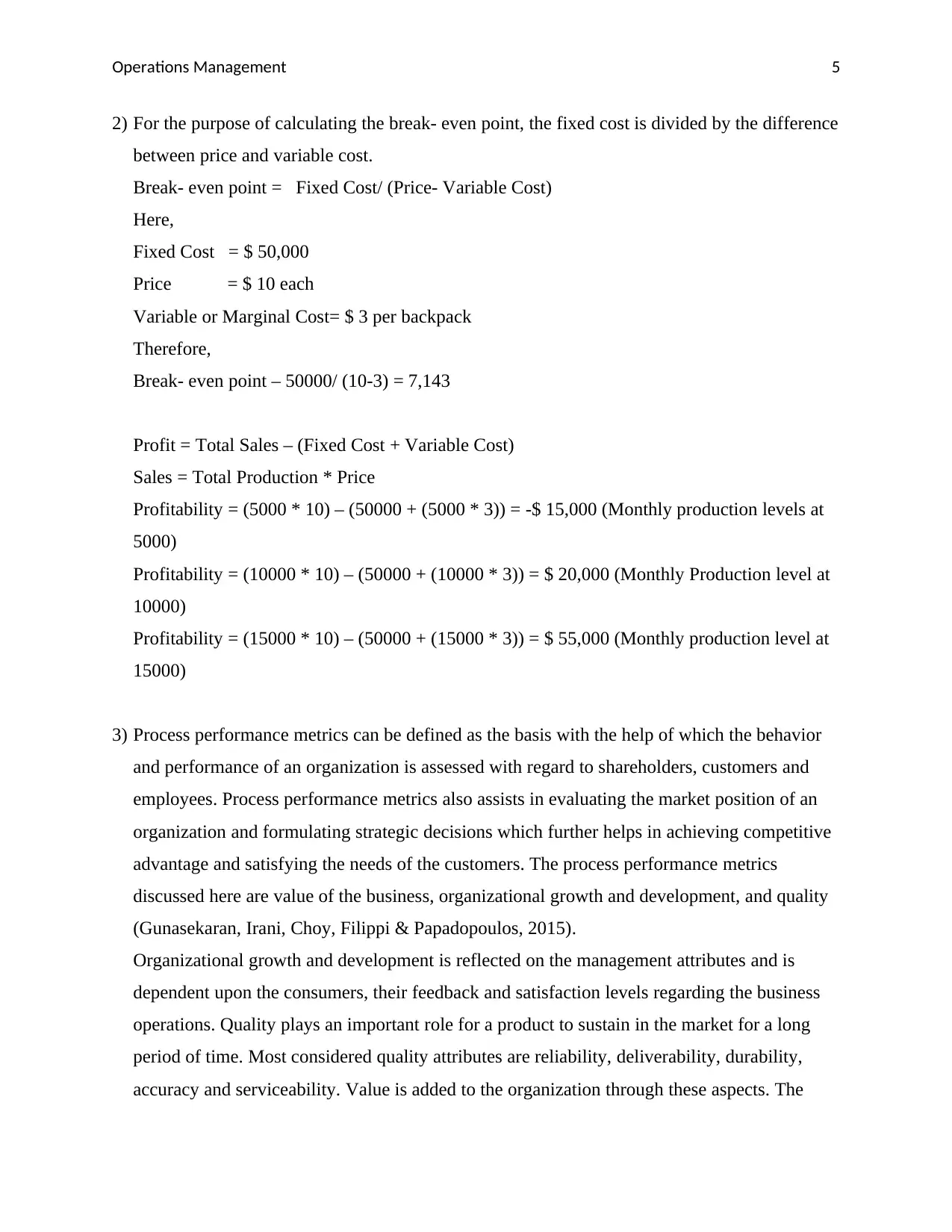
Operations Management 5
2) For the purpose of calculating the break- even point, the fixed cost is divided by the difference
between price and variable cost.
Break- even point = Fixed Cost/ (Price- Variable Cost)
Here,
Fixed Cost = $ 50,000
Price = $ 10 each
Variable or Marginal Cost= $ 3 per backpack
Therefore,
Break- even point – 50000/ (10-3) = 7,143
Profit = Total Sales – (Fixed Cost + Variable Cost)
Sales = Total Production * Price
Profitability = (5000 * 10) – (50000 + (5000 * 3)) = -$ 15,000 (Monthly production levels at
5000)
Profitability = (10000 * 10) – (50000 + (10000 * 3)) = $ 20,000 (Monthly Production level at
10000)
Profitability = (15000 * 10) – (50000 + (15000 * 3)) = $ 55,000 (Monthly production level at
15000)
3) Process performance metrics can be defined as the basis with the help of which the behavior
and performance of an organization is assessed with regard to shareholders, customers and
employees. Process performance metrics also assists in evaluating the market position of an
organization and formulating strategic decisions which further helps in achieving competitive
advantage and satisfying the needs of the customers. The process performance metrics
discussed here are value of the business, organizational growth and development, and quality
(Gunasekaran, Irani, Choy, Filippi & Papadopoulos, 2015).
Organizational growth and development is reflected on the management attributes and is
dependent upon the consumers, their feedback and satisfaction levels regarding the business
operations. Quality plays an important role for a product to sustain in the market for a long
period of time. Most considered quality attributes are reliability, deliverability, durability,
accuracy and serviceability. Value is added to the organization through these aspects. The
2) For the purpose of calculating the break- even point, the fixed cost is divided by the difference
between price and variable cost.
Break- even point = Fixed Cost/ (Price- Variable Cost)
Here,
Fixed Cost = $ 50,000
Price = $ 10 each
Variable or Marginal Cost= $ 3 per backpack
Therefore,
Break- even point – 50000/ (10-3) = 7,143
Profit = Total Sales – (Fixed Cost + Variable Cost)
Sales = Total Production * Price
Profitability = (5000 * 10) – (50000 + (5000 * 3)) = -$ 15,000 (Monthly production levels at
5000)
Profitability = (10000 * 10) – (50000 + (10000 * 3)) = $ 20,000 (Monthly Production level at
10000)
Profitability = (15000 * 10) – (50000 + (15000 * 3)) = $ 55,000 (Monthly production level at
15000)
3) Process performance metrics can be defined as the basis with the help of which the behavior
and performance of an organization is assessed with regard to shareholders, customers and
employees. Process performance metrics also assists in evaluating the market position of an
organization and formulating strategic decisions which further helps in achieving competitive
advantage and satisfying the needs of the customers. The process performance metrics
discussed here are value of the business, organizational growth and development, and quality
(Gunasekaran, Irani, Choy, Filippi & Papadopoulos, 2015).
Organizational growth and development is reflected on the management attributes and is
dependent upon the consumers, their feedback and satisfaction levels regarding the business
operations. Quality plays an important role for a product to sustain in the market for a long
period of time. Most considered quality attributes are reliability, deliverability, durability,
accuracy and serviceability. Value is added to the organization through these aspects. The
⊘ This is a preview!⊘
Do you want full access?
Subscribe today to unlock all pages.

Trusted by 1+ million students worldwide
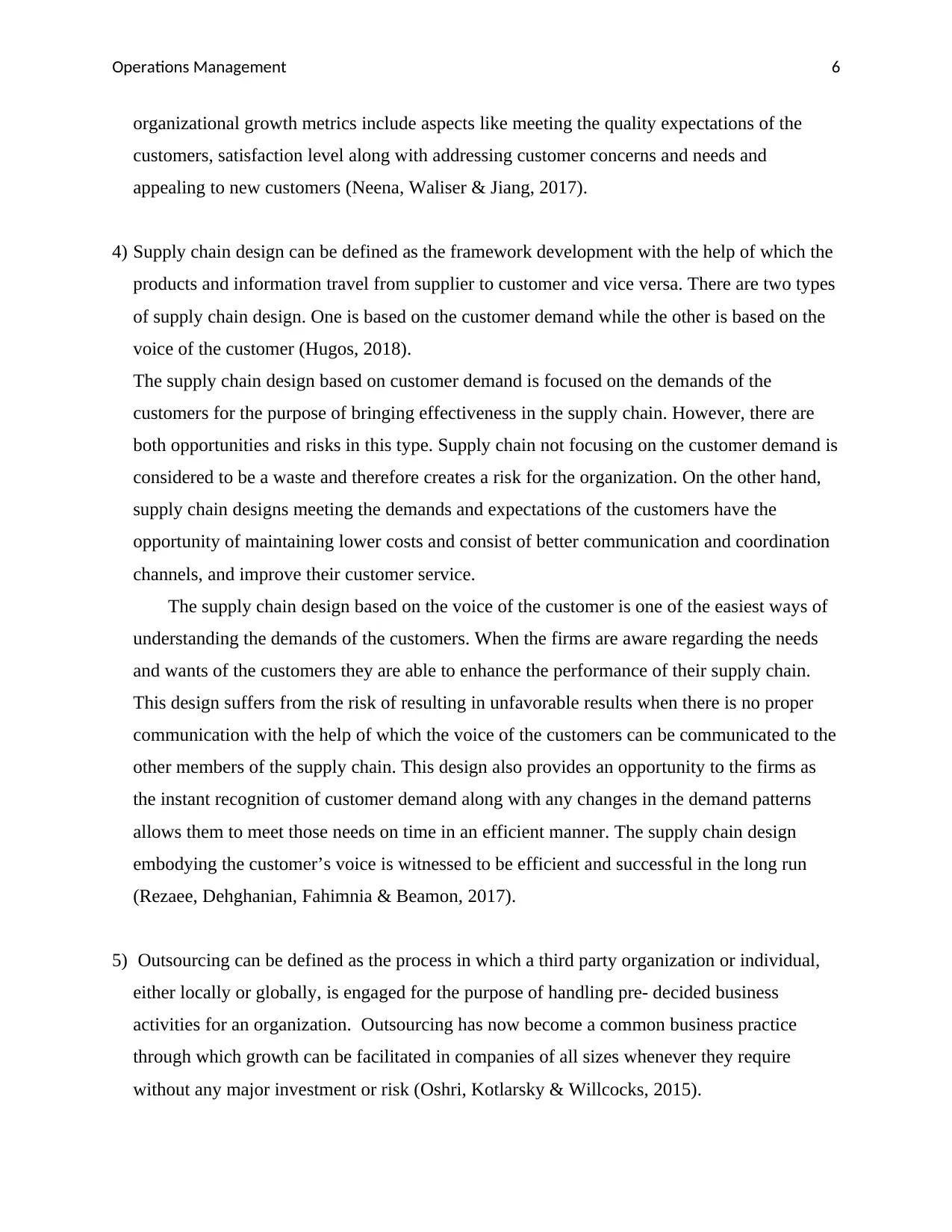
Operations Management 6
organizational growth metrics include aspects like meeting the quality expectations of the
customers, satisfaction level along with addressing customer concerns and needs and
appealing to new customers (Neena, Waliser & Jiang, 2017).
4) Supply chain design can be defined as the framework development with the help of which the
products and information travel from supplier to customer and vice versa. There are two types
of supply chain design. One is based on the customer demand while the other is based on the
voice of the customer (Hugos, 2018).
The supply chain design based on customer demand is focused on the demands of the
customers for the purpose of bringing effectiveness in the supply chain. However, there are
both opportunities and risks in this type. Supply chain not focusing on the customer demand is
considered to be a waste and therefore creates a risk for the organization. On the other hand,
supply chain designs meeting the demands and expectations of the customers have the
opportunity of maintaining lower costs and consist of better communication and coordination
channels, and improve their customer service.
The supply chain design based on the voice of the customer is one of the easiest ways of
understanding the demands of the customers. When the firms are aware regarding the needs
and wants of the customers they are able to enhance the performance of their supply chain.
This design suffers from the risk of resulting in unfavorable results when there is no proper
communication with the help of which the voice of the customers can be communicated to the
other members of the supply chain. This design also provides an opportunity to the firms as
the instant recognition of customer demand along with any changes in the demand patterns
allows them to meet those needs on time in an efficient manner. The supply chain design
embodying the customer’s voice is witnessed to be efficient and successful in the long run
(Rezaee, Dehghanian, Fahimnia & Beamon, 2017).
5) Outsourcing can be defined as the process in which a third party organization or individual,
either locally or globally, is engaged for the purpose of handling pre- decided business
activities for an organization. Outsourcing has now become a common business practice
through which growth can be facilitated in companies of all sizes whenever they require
without any major investment or risk (Oshri, Kotlarsky & Willcocks, 2015).
organizational growth metrics include aspects like meeting the quality expectations of the
customers, satisfaction level along with addressing customer concerns and needs and
appealing to new customers (Neena, Waliser & Jiang, 2017).
4) Supply chain design can be defined as the framework development with the help of which the
products and information travel from supplier to customer and vice versa. There are two types
of supply chain design. One is based on the customer demand while the other is based on the
voice of the customer (Hugos, 2018).
The supply chain design based on customer demand is focused on the demands of the
customers for the purpose of bringing effectiveness in the supply chain. However, there are
both opportunities and risks in this type. Supply chain not focusing on the customer demand is
considered to be a waste and therefore creates a risk for the organization. On the other hand,
supply chain designs meeting the demands and expectations of the customers have the
opportunity of maintaining lower costs and consist of better communication and coordination
channels, and improve their customer service.
The supply chain design based on the voice of the customer is one of the easiest ways of
understanding the demands of the customers. When the firms are aware regarding the needs
and wants of the customers they are able to enhance the performance of their supply chain.
This design suffers from the risk of resulting in unfavorable results when there is no proper
communication with the help of which the voice of the customers can be communicated to the
other members of the supply chain. This design also provides an opportunity to the firms as
the instant recognition of customer demand along with any changes in the demand patterns
allows them to meet those needs on time in an efficient manner. The supply chain design
embodying the customer’s voice is witnessed to be efficient and successful in the long run
(Rezaee, Dehghanian, Fahimnia & Beamon, 2017).
5) Outsourcing can be defined as the process in which a third party organization or individual,
either locally or globally, is engaged for the purpose of handling pre- decided business
activities for an organization. Outsourcing has now become a common business practice
through which growth can be facilitated in companies of all sizes whenever they require
without any major investment or risk (Oshri, Kotlarsky & Willcocks, 2015).
Paraphrase This Document
Need a fresh take? Get an instant paraphrase of this document with our AI Paraphraser
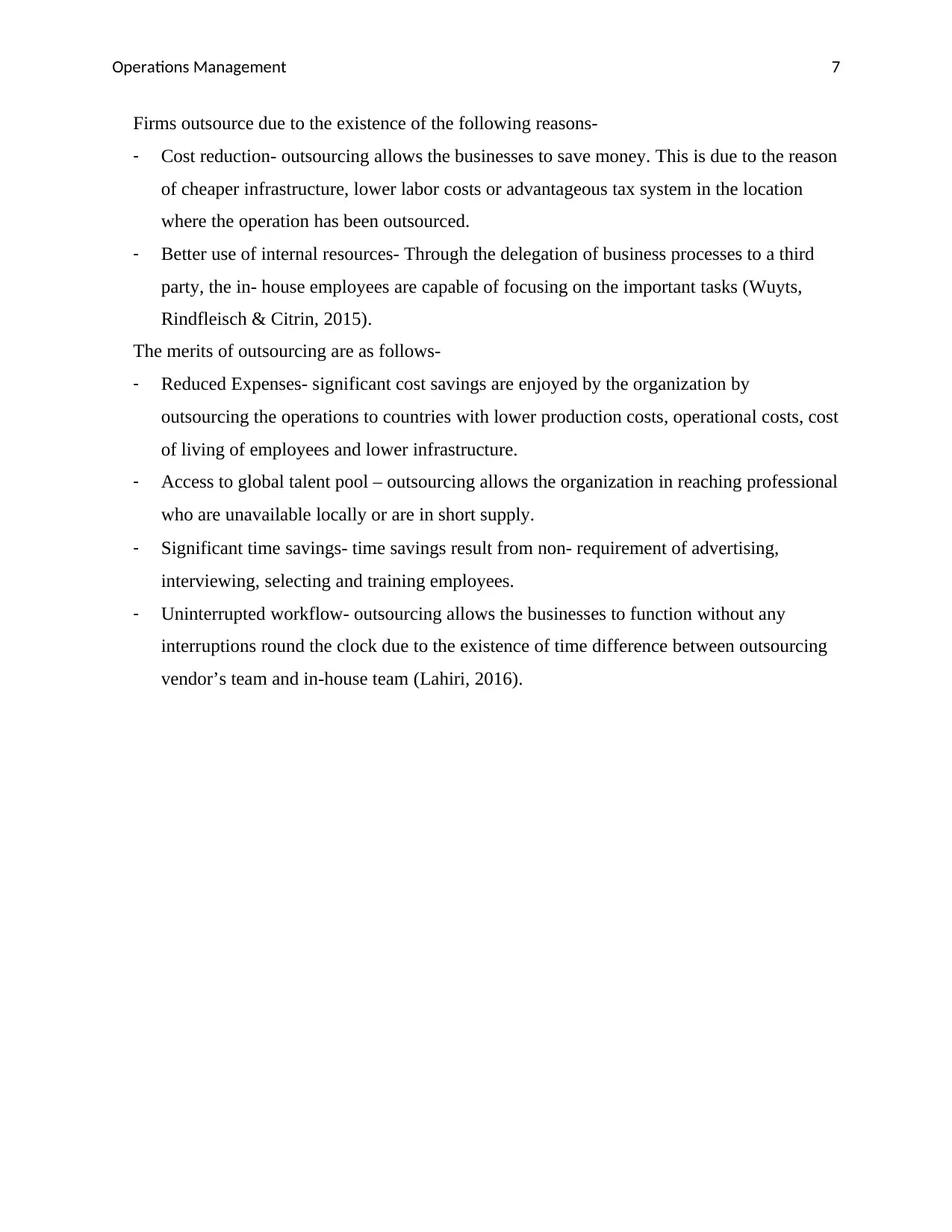
Operations Management 7
Firms outsource due to the existence of the following reasons-
- Cost reduction- outsourcing allows the businesses to save money. This is due to the reason
of cheaper infrastructure, lower labor costs or advantageous tax system in the location
where the operation has been outsourced.
- Better use of internal resources- Through the delegation of business processes to a third
party, the in- house employees are capable of focusing on the important tasks (Wuyts,
Rindfleisch & Citrin, 2015).
The merits of outsourcing are as follows-
- Reduced Expenses- significant cost savings are enjoyed by the organization by
outsourcing the operations to countries with lower production costs, operational costs, cost
of living of employees and lower infrastructure.
- Access to global talent pool – outsourcing allows the organization in reaching professional
who are unavailable locally or are in short supply.
- Significant time savings- time savings result from non- requirement of advertising,
interviewing, selecting and training employees.
- Uninterrupted workflow- outsourcing allows the businesses to function without any
interruptions round the clock due to the existence of time difference between outsourcing
vendor’s team and in-house team (Lahiri, 2016).
Firms outsource due to the existence of the following reasons-
- Cost reduction- outsourcing allows the businesses to save money. This is due to the reason
of cheaper infrastructure, lower labor costs or advantageous tax system in the location
where the operation has been outsourced.
- Better use of internal resources- Through the delegation of business processes to a third
party, the in- house employees are capable of focusing on the important tasks (Wuyts,
Rindfleisch & Citrin, 2015).
The merits of outsourcing are as follows-
- Reduced Expenses- significant cost savings are enjoyed by the organization by
outsourcing the operations to countries with lower production costs, operational costs, cost
of living of employees and lower infrastructure.
- Access to global talent pool – outsourcing allows the organization in reaching professional
who are unavailable locally or are in short supply.
- Significant time savings- time savings result from non- requirement of advertising,
interviewing, selecting and training employees.
- Uninterrupted workflow- outsourcing allows the businesses to function without any
interruptions round the clock due to the existence of time difference between outsourcing
vendor’s team and in-house team (Lahiri, 2016).
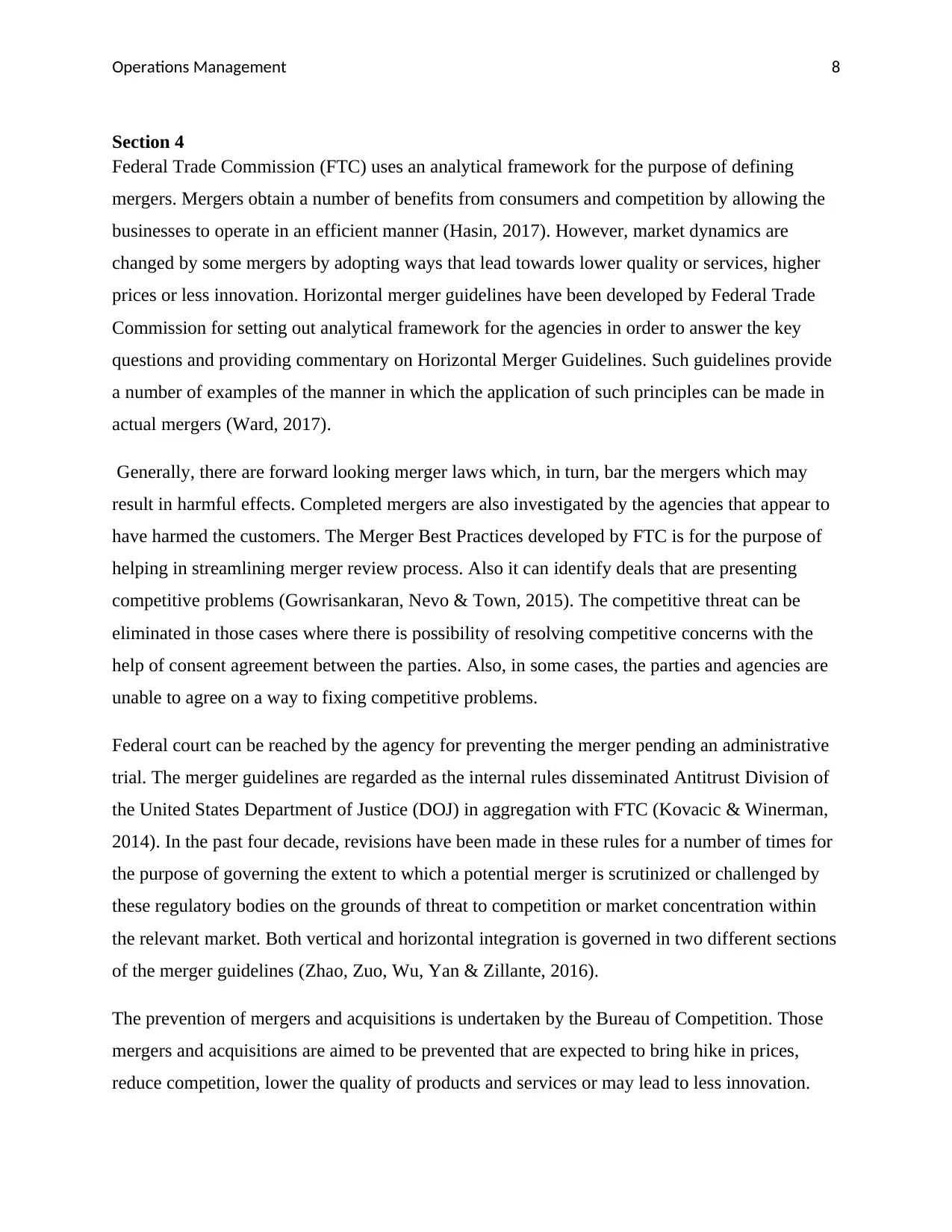
Operations Management 8
Section 4
Federal Trade Commission (FTC) uses an analytical framework for the purpose of defining
mergers. Mergers obtain a number of benefits from consumers and competition by allowing the
businesses to operate in an efficient manner (Hasin, 2017). However, market dynamics are
changed by some mergers by adopting ways that lead towards lower quality or services, higher
prices or less innovation. Horizontal merger guidelines have been developed by Federal Trade
Commission for setting out analytical framework for the agencies in order to answer the key
questions and providing commentary on Horizontal Merger Guidelines. Such guidelines provide
a number of examples of the manner in which the application of such principles can be made in
actual mergers (Ward, 2017).
Generally, there are forward looking merger laws which, in turn, bar the mergers which may
result in harmful effects. Completed mergers are also investigated by the agencies that appear to
have harmed the customers. The Merger Best Practices developed by FTC is for the purpose of
helping in streamlining merger review process. Also it can identify deals that are presenting
competitive problems (Gowrisankaran, Nevo & Town, 2015). The competitive threat can be
eliminated in those cases where there is possibility of resolving competitive concerns with the
help of consent agreement between the parties. Also, in some cases, the parties and agencies are
unable to agree on a way to fixing competitive problems.
Federal court can be reached by the agency for preventing the merger pending an administrative
trial. The merger guidelines are regarded as the internal rules disseminated Antitrust Division of
the United States Department of Justice (DOJ) in aggregation with FTC (Kovacic & Winerman,
2014). In the past four decade, revisions have been made in these rules for a number of times for
the purpose of governing the extent to which a potential merger is scrutinized or challenged by
these regulatory bodies on the grounds of threat to competition or market concentration within
the relevant market. Both vertical and horizontal integration is governed in two different sections
of the merger guidelines (Zhao, Zuo, Wu, Yan & Zillante, 2016).
The prevention of mergers and acquisitions is undertaken by the Bureau of Competition. Those
mergers and acquisitions are aimed to be prevented that are expected to bring hike in prices,
reduce competition, lower the quality of products and services or may lead to less innovation.
Section 4
Federal Trade Commission (FTC) uses an analytical framework for the purpose of defining
mergers. Mergers obtain a number of benefits from consumers and competition by allowing the
businesses to operate in an efficient manner (Hasin, 2017). However, market dynamics are
changed by some mergers by adopting ways that lead towards lower quality or services, higher
prices or less innovation. Horizontal merger guidelines have been developed by Federal Trade
Commission for setting out analytical framework for the agencies in order to answer the key
questions and providing commentary on Horizontal Merger Guidelines. Such guidelines provide
a number of examples of the manner in which the application of such principles can be made in
actual mergers (Ward, 2017).
Generally, there are forward looking merger laws which, in turn, bar the mergers which may
result in harmful effects. Completed mergers are also investigated by the agencies that appear to
have harmed the customers. The Merger Best Practices developed by FTC is for the purpose of
helping in streamlining merger review process. Also it can identify deals that are presenting
competitive problems (Gowrisankaran, Nevo & Town, 2015). The competitive threat can be
eliminated in those cases where there is possibility of resolving competitive concerns with the
help of consent agreement between the parties. Also, in some cases, the parties and agencies are
unable to agree on a way to fixing competitive problems.
Federal court can be reached by the agency for preventing the merger pending an administrative
trial. The merger guidelines are regarded as the internal rules disseminated Antitrust Division of
the United States Department of Justice (DOJ) in aggregation with FTC (Kovacic & Winerman,
2014). In the past four decade, revisions have been made in these rules for a number of times for
the purpose of governing the extent to which a potential merger is scrutinized or challenged by
these regulatory bodies on the grounds of threat to competition or market concentration within
the relevant market. Both vertical and horizontal integration is governed in two different sections
of the merger guidelines (Zhao, Zuo, Wu, Yan & Zillante, 2016).
The prevention of mergers and acquisitions is undertaken by the Bureau of Competition. Those
mergers and acquisitions are aimed to be prevented that are expected to bring hike in prices,
reduce competition, lower the quality of products and services or may lead to less innovation.
⊘ This is a preview!⊘
Do you want full access?
Subscribe today to unlock all pages.

Trusted by 1+ million students worldwide

Operations Management 9
The market dynamics is investigated by the economists from Federal Trade Commission’s
Bureau of Economics along with bureau lawyers for the purpose of determining whether the
proposed merger is expected to harm the consumers. Formal legal actions are often taken by the
Federal Trade Commission when necessary in order to stop the merger, either before an
administrative law judge or in federal court.
If I was in Congress in today, I would have modified the guidelines in accordance with the
requirements of the present time. Since the guidelines are criticized due to the reason of not
updating efficiency analysis, I would make sure that the efficiency analysis is updated from time
to time. The criticisms also include the fact that the guidelines may not be adopted by the court
and that the principles are not embodied in the guidelines that reflect dynamic competition
(Pierce Jr, 2014). Therefore, I would frame the guidelines or make the requisite changes in the
guidelines in order to make it suitable and adaptable by the court. Also, I would embody some
principles in the guidelines which will reflect dynamic competition. Such legislation will be
valuable. Reforms will also be introduced in order to streamline the process of merger review.
This will be done by way of formalizing the well- defines best practices. Rapid identification of
the relevant issues will become much easier along with the usage of constant investigation
timetables and preparation of better focused second requests.
The adoption of such reforms will bring improvement in the merger review process of Federal
Trade Commission with the help of making the parties, staff and the outside counsel more
accountable for any deviations from the prior formed best practices. With the help of those
reforms, the good faith intention of Federal Trade Commission will be demonstrated to work
hard for the purpose of minimizing the burdens caused by the merger review process.
Furthermore, the value of such legislation will increase as it is anticipated that the parties will
come up with the spirit of cooperation while approaching the merger review process. the reforms
will be further designed in a manner such that the staff and the parties will be permitted to
quickly identify the relevant substantive issues and concentrate on the relevant data and
documents. For example, dynamic competition will exist and will be appreciated by the court
and organizations (Kovacic, 2015).
The market dynamics is investigated by the economists from Federal Trade Commission’s
Bureau of Economics along with bureau lawyers for the purpose of determining whether the
proposed merger is expected to harm the consumers. Formal legal actions are often taken by the
Federal Trade Commission when necessary in order to stop the merger, either before an
administrative law judge or in federal court.
If I was in Congress in today, I would have modified the guidelines in accordance with the
requirements of the present time. Since the guidelines are criticized due to the reason of not
updating efficiency analysis, I would make sure that the efficiency analysis is updated from time
to time. The criticisms also include the fact that the guidelines may not be adopted by the court
and that the principles are not embodied in the guidelines that reflect dynamic competition
(Pierce Jr, 2014). Therefore, I would frame the guidelines or make the requisite changes in the
guidelines in order to make it suitable and adaptable by the court. Also, I would embody some
principles in the guidelines which will reflect dynamic competition. Such legislation will be
valuable. Reforms will also be introduced in order to streamline the process of merger review.
This will be done by way of formalizing the well- defines best practices. Rapid identification of
the relevant issues will become much easier along with the usage of constant investigation
timetables and preparation of better focused second requests.
The adoption of such reforms will bring improvement in the merger review process of Federal
Trade Commission with the help of making the parties, staff and the outside counsel more
accountable for any deviations from the prior formed best practices. With the help of those
reforms, the good faith intention of Federal Trade Commission will be demonstrated to work
hard for the purpose of minimizing the burdens caused by the merger review process.
Furthermore, the value of such legislation will increase as it is anticipated that the parties will
come up with the spirit of cooperation while approaching the merger review process. the reforms
will be further designed in a manner such that the staff and the parties will be permitted to
quickly identify the relevant substantive issues and concentrate on the relevant data and
documents. For example, dynamic competition will exist and will be appreciated by the court
and organizations (Kovacic, 2015).
Paraphrase This Document
Need a fresh take? Get an instant paraphrase of this document with our AI Paraphraser
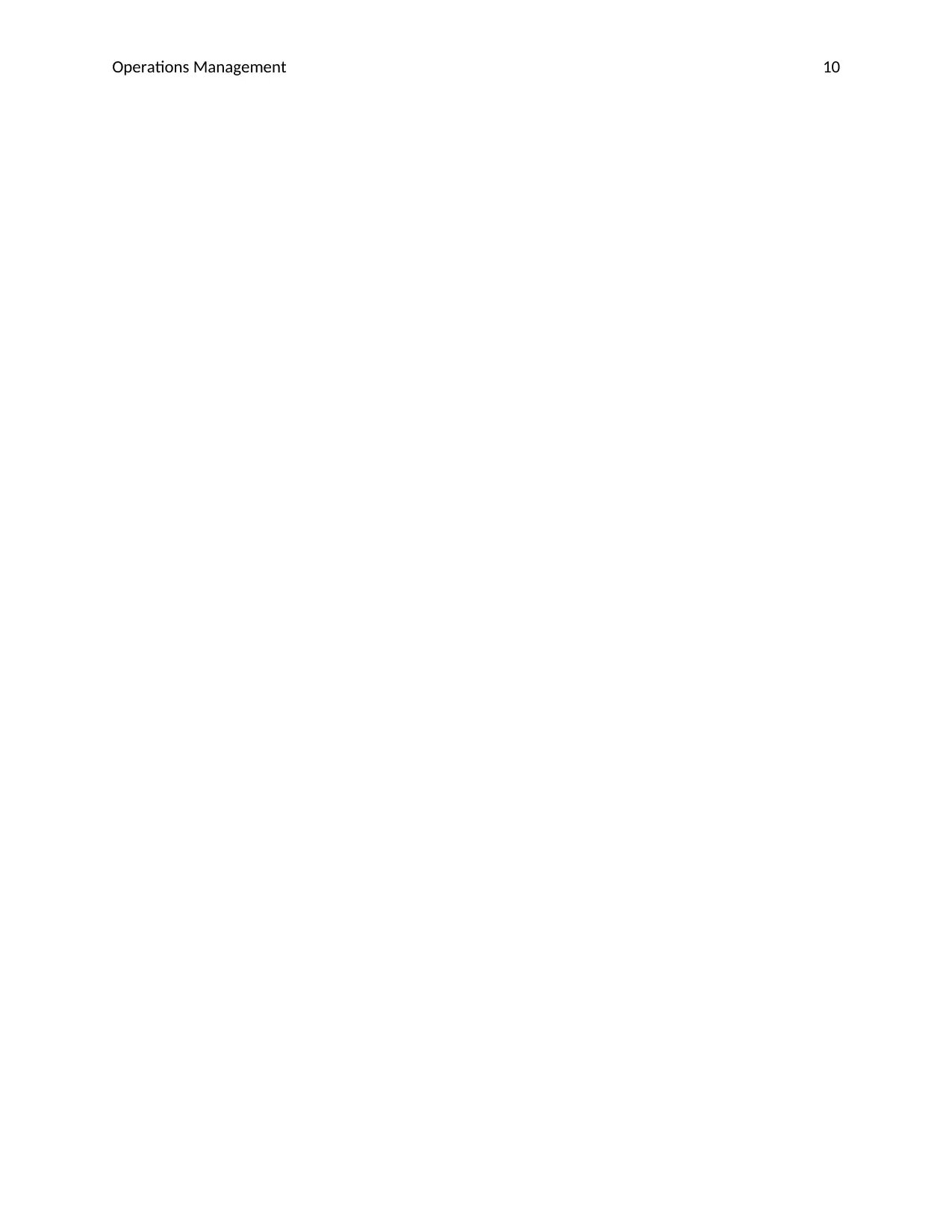
Operations Management 10
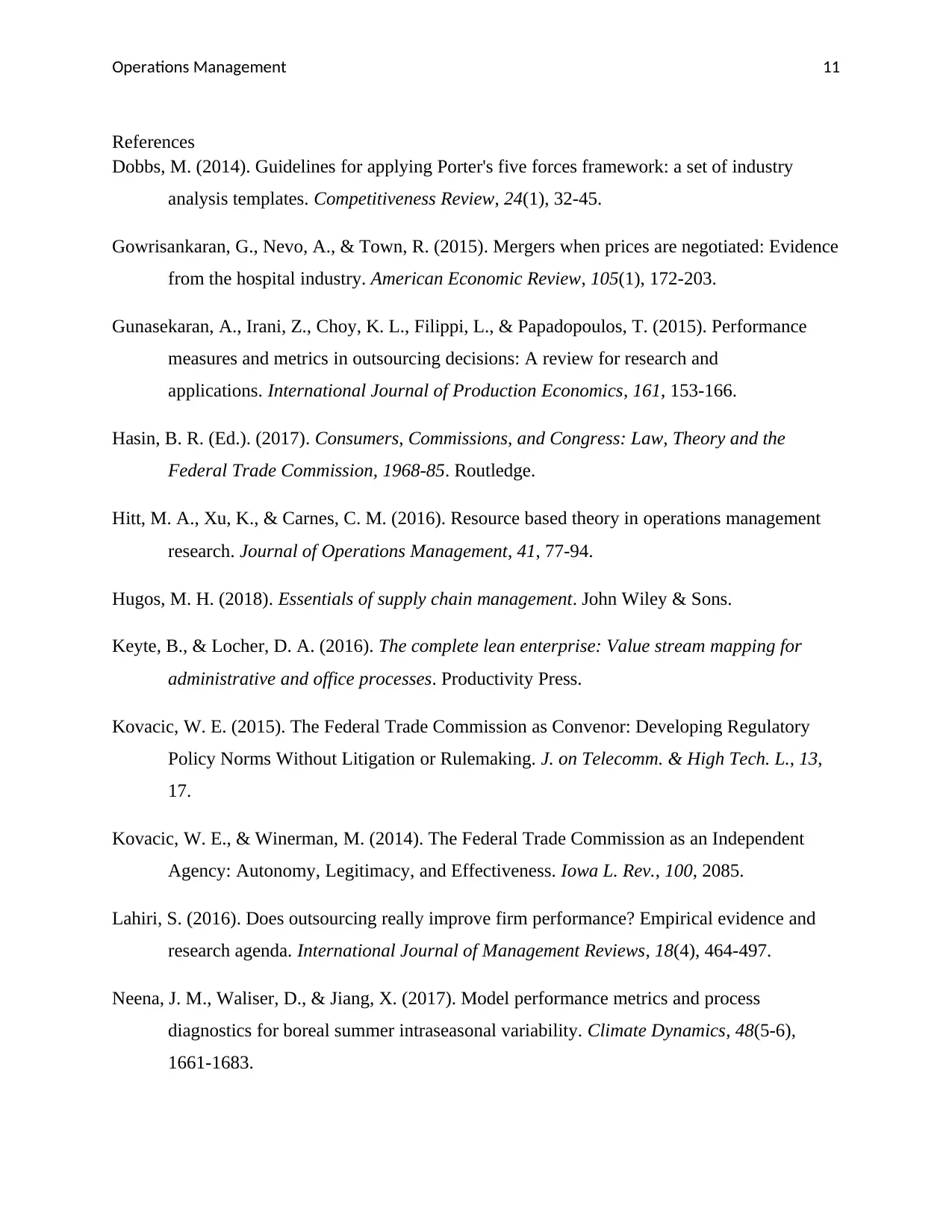
Operations Management 11
References
Dobbs, M. (2014). Guidelines for applying Porter's five forces framework: a set of industry
analysis templates. Competitiveness Review, 24(1), 32-45.
Gowrisankaran, G., Nevo, A., & Town, R. (2015). Mergers when prices are negotiated: Evidence
from the hospital industry. American Economic Review, 105(1), 172-203.
Gunasekaran, A., Irani, Z., Choy, K. L., Filippi, L., & Papadopoulos, T. (2015). Performance
measures and metrics in outsourcing decisions: A review for research and
applications. International Journal of Production Economics, 161, 153-166.
Hasin, B. R. (Ed.). (2017). Consumers, Commissions, and Congress: Law, Theory and the
Federal Trade Commission, 1968-85. Routledge.
Hitt, M. A., Xu, K., & Carnes, C. M. (2016). Resource based theory in operations management
research. Journal of Operations Management, 41, 77-94.
Hugos, M. H. (2018). Essentials of supply chain management. John Wiley & Sons.
Keyte, B., & Locher, D. A. (2016). The complete lean enterprise: Value stream mapping for
administrative and office processes. Productivity Press.
Kovacic, W. E. (2015). The Federal Trade Commission as Convenor: Developing Regulatory
Policy Norms Without Litigation or Rulemaking. J. on Telecomm. & High Tech. L., 13,
17.
Kovacic, W. E., & Winerman, M. (2014). The Federal Trade Commission as an Independent
Agency: Autonomy, Legitimacy, and Effectiveness. Iowa L. Rev., 100, 2085.
Lahiri, S. (2016). Does outsourcing really improve firm performance? Empirical evidence and
research agenda. International Journal of Management Reviews, 18(4), 464-497.
Neena, J. M., Waliser, D., & Jiang, X. (2017). Model performance metrics and process
diagnostics for boreal summer intraseasonal variability. Climate Dynamics, 48(5-6),
1661-1683.
References
Dobbs, M. (2014). Guidelines for applying Porter's five forces framework: a set of industry
analysis templates. Competitiveness Review, 24(1), 32-45.
Gowrisankaran, G., Nevo, A., & Town, R. (2015). Mergers when prices are negotiated: Evidence
from the hospital industry. American Economic Review, 105(1), 172-203.
Gunasekaran, A., Irani, Z., Choy, K. L., Filippi, L., & Papadopoulos, T. (2015). Performance
measures and metrics in outsourcing decisions: A review for research and
applications. International Journal of Production Economics, 161, 153-166.
Hasin, B. R. (Ed.). (2017). Consumers, Commissions, and Congress: Law, Theory and the
Federal Trade Commission, 1968-85. Routledge.
Hitt, M. A., Xu, K., & Carnes, C. M. (2016). Resource based theory in operations management
research. Journal of Operations Management, 41, 77-94.
Hugos, M. H. (2018). Essentials of supply chain management. John Wiley & Sons.
Keyte, B., & Locher, D. A. (2016). The complete lean enterprise: Value stream mapping for
administrative and office processes. Productivity Press.
Kovacic, W. E. (2015). The Federal Trade Commission as Convenor: Developing Regulatory
Policy Norms Without Litigation or Rulemaking. J. on Telecomm. & High Tech. L., 13,
17.
Kovacic, W. E., & Winerman, M. (2014). The Federal Trade Commission as an Independent
Agency: Autonomy, Legitimacy, and Effectiveness. Iowa L. Rev., 100, 2085.
Lahiri, S. (2016). Does outsourcing really improve firm performance? Empirical evidence and
research agenda. International Journal of Management Reviews, 18(4), 464-497.
Neena, J. M., Waliser, D., & Jiang, X. (2017). Model performance metrics and process
diagnostics for boreal summer intraseasonal variability. Climate Dynamics, 48(5-6),
1661-1683.
⊘ This is a preview!⊘
Do you want full access?
Subscribe today to unlock all pages.

Trusted by 1+ million students worldwide
1 out of 13
Related Documents
Your All-in-One AI-Powered Toolkit for Academic Success.
+13062052269
info@desklib.com
Available 24*7 on WhatsApp / Email
![[object Object]](/_next/static/media/star-bottom.7253800d.svg)
Unlock your academic potential
Copyright © 2020–2025 A2Z Services. All Rights Reserved. Developed and managed by ZUCOL.





